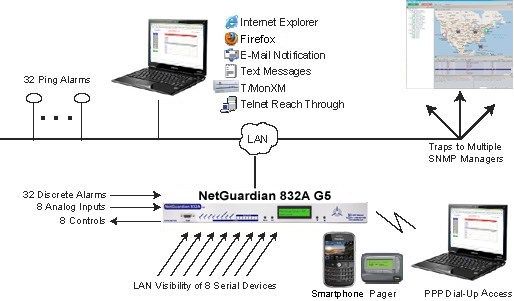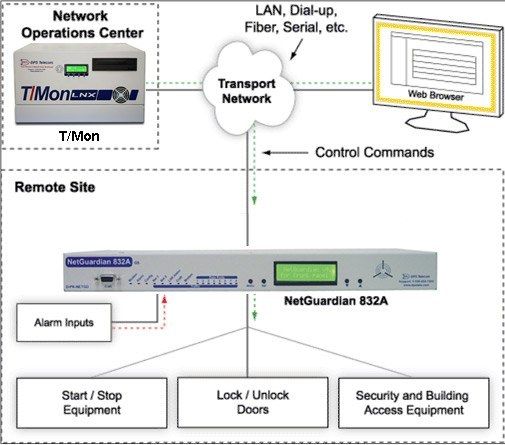Download our free Monitoring Fundamentals Tutorial.
An introduction to Monitoring Fundamentals strictly from the perspective of telecom network alarm management.
1-800-693-0351
Have a specific question? Ask our team of expert engineers and get a specific answer!
Sign up for the next DPS Factory Training!

Whether you're new to our equipment or you've used it for years, DPS factory training is the best way to get more from your monitoring.
Reserve Your Seat TodayIf you have a communications infrastructure, energy grid, or a wide-reaching network, you likely have resources in many areas throughout the network. To properly maintain your network and sites, you'll need to know the status of your network resources, but you can't be everywhere at once. You'll need to place devices at your sites to report back to you on the status of your network's physical resources. This is the practice typically known as "telemetry monitoring."
Telemetry systems, done properly, play an important role in providing you with information about the health of your network, so you can respond intelligently to prevent hardware failure and network downtime. Without telemetry monitoring, you're likely not to know about network troubles until equipment fails or an outage occurs, and, even then, without information on the nature of the failure, you may spend longer getting the network back online. Proper telemetry reporting makes network management a proactive enterprise, reducing maintenance costs and increasing uptime and performance.
Telemetry monitoring starts with what are typically known as Remote Telemetry Units (RTUs). An RTU monitors the status of equipment and the environment at your site, reporting an alarm to you when something out of the ordinary occurs. RTUs typically set three types of alarms:

Discrete alarms provide basic binary reporting at your site. They'll notify you of on-off, open or closed, sorts of conditions. Many of the types of devices to which you'll wire discrete points will also indicate alarm severity - critical, major, and minor - helping you qualify alarms when they occur.
Analog inputs monitor a range of sensor technologies and sensor-based values. These sensors include temperature, humidity, and fuel levels. Analog alarms are set when the analog sensor measures a value crossing a configurable threshold, indicating that there's a problem of sorts at your site. Because of the nature of analog alarms, analog sensors don't typically monitor equipment directly, but the operating environment and availability of power (fuel levels, battery voltages, etc.) at your site. However, this doesn't make them any less useful than discrete alarms. For example, imagine you were to have a temperature sensor at your site and set a minor threshold value at just above the set level for the air conditioning at your site. If the alarm were to set, it would indicate that your HVAC services have not come on or are not working properly endangering the equipment at that site.
Ping alarms are simple alarms that simply express connectivity between the RTU and other devices, so you know when you have network issues. The RTU will attempt to ping a target. If the ping does not respond, the RTU will set an alarm and you'll know that you may have a real-time network issue.
When an alarm occurs, the Remote Telemetry Unit will report back to you. Some of the more basic telemetry devices will simply report to a terminal window, listing events as they occur. While this does still fulfill the reporting requirement of the RTU, it requires you or one of your fellow technicians to plant themselves in front of the terminal to watch for problems. Some of the more feature-rich RTUs, like the NetGuardian series from DPS Telecom, send email, text, and pager messages indicating when an alarm has occurred. This allows you and your technicians to keep up on what's happening in your network at all times, when they're at a site or in transit, preventing network alarms from going unnoticed.
While it is important to resolve all of the alarms that you receive to keep your network up and online, you don't want to have to roll a truck every time equipment needs resetting or a generator needs to be turned on. To prevent truck rolls for mundane network issues, you should look for an RTU with control relays, simple circuits you can wire to equipment at your site and activate remotely. With control relays, you can turn on and off equipment, lock and unlock doors, or reset equipment as necessary. Sophisticated RTUs like the NetGuardian series even allow you to derive controls to operate when an alarm is set. For example, you could set a control relay to operate a secondary generator when the analog fuel sensor for the primary generator reads a low level of fuel, preventing you from having to make a trip just to flip on a generator.

Some of the NetGuardian RTUs provide a terminal server as well, so you can reach-through your RTU to your serial-only devices on site. So, when you need to perform a soft reset or execute a command on a piece of serial-only equipment, you don't necessarily have to roll a truck. You can do it right from your office chair.
Telemetry monitoring is designed to help you more intelligently manage your network. Being able to get more done without having to burn fuel and travel time is definitely a part of that convenience. As you look at RTUs for your telemetry monitoring systems, consider control features that provide remote control options as well.
You can't afford to leave some sites in the blind. Each site that goes unwatched represents a liability to your network and potentially increased maintenance costs. Luckily, working with a company like DPS Telecom, you can get the perfect-fit RTU for any of your sites. RTUs are available with as few as 2 discrete inputs, up to 64 (and expansion units are available after that). If you need to support a specific transport - T1, fiber, POTS - there's an RTU to fit your need.
As your network grows, working with individual telemetry monitoring devices may prove cumbersome in the long term. With an increasing number of sites, it will become less feasible to monitor your alarms across multiple interface windows, and your technicians may well be confused as they receive alarm notifications from multiple sources across the network. To prevent confusion and maintain efficient maintenance practices, you will want to install a master station to manage your telemetry monitoring network.

A robust network alarm master will bring in all your network alarms and make monitoring and administrating your network easier. For example, T/Mon, DPS Telecom's network alarm management platform, can bring in alarms from all of your equipment, even equipment running legacy and proprietary protocols. So, if you're running a mixture of RTUs across the network, or simply have some equipment that reports its own telemetry data, T/Mon can poll it and report it to you.
Like your RTUs, the master station will provide notification for network alarms. However, unlike some RTUs, the master station is in a unique position to provide a level of sophistication for alarm notifications that your RTUs aren't. For example, T/Mon, the alarm management platform from DPS Telecom, is capable of sending progressive notifications, so if the primary technician for a site does not receive or acknowledge the notification, it'll go to the next tech down the line. This makes your telemetry master station effectively a dispatcher, automatically organizing your technicians' network maintenance efforts.
The master station also brings all of your telemetry monitoring devices into a single interface. Like the RTUs, the master will allow technicians to view telemetry data, but unifying everything to a single interface, the master station reduces the chances that a technician accesses the wrong device or gets himself crossed up.
Telemetry monitoring systems are essential to efficient network managing. The right remote telemetry devices and master station will reduce maintenance costs, ensure more reliable network performance and greater uptime, and, most importantly, make your job easier.
Related Topics:
Remote Alarm Management